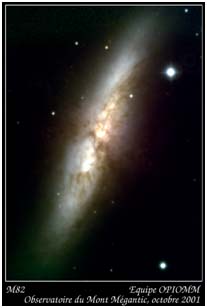| An international team of astronomers discovers the first very high energy gamma rays from the Cigar Galaxy, M82 |
| 2009-11-22 |
 McGill University researchers and their colleagues in VERITAS, an international collaboration of astronomers, have discovered the first example of a very-high-energy gamma-ray source associated with a starburst galaxy - a discovery that provides fundamental insight into the origin of cosmic rays. Their results which provide critical evidence to help scientists understand the origin of cosmic rays by clearly linking the processes related to the life-cycle of stars with the acceleration of cosmic rays, will be published in the journal Nature. McGill University researchers and their colleagues in VERITAS, an international collaboration of astronomers, have discovered the first example of a very-high-energy gamma-ray source associated with a starburst galaxy - a discovery that provides fundamental insight into the origin of cosmic rays. Their results which provide critical evidence to help scientists understand the origin of cosmic rays by clearly linking the processes related to the life-cycle of stars with the acceleration of cosmic rays, will be published in the journal Nature.
The work of McGill professors David Hanna and Kenneth Ragan, from the Department of Physics, may help to unravel the mystery of cosmic rays, energetic particles which bombard the Earth. These particles are produced in violent processes in our own Milky Way and in other galaxies. Although the details of their origin remain a mystery nearly a century after their discovery, it has long been thought that they originate in exploding stars called supernovae. The VERITAS observation of high-energy gamma rays coming from an area of intense stellar production and death will help to shed more light on the details of cosmic ray production.
In this discovery, researchers found starburst galaxy M82 to emit very energetic gamma rays. While dozens of objects have been observed to emit these energetic gamma rays, M82 is unique because it is the first starburst galaxy to be observed doing so. Starburst galaxies carry that name because they are sites of intense star formation -- and thus have large numbers of young, massive stars and supernovae (exploded high-mass stars). For a starburst galaxy to be observed as a gamma-ray emitter thus ties together gamma-ray production with cosmic ray -- charged particle -- production and acceleration in these supernovae, which may help us to understand the origin of cosmic rays.
"VERITAS is the most sensitive instrument in the world for this type of study, and this discovery of a new class of very-high-energy gamma ray emitters will provide more clues to the production and acceleration of cosmic rays," said Kenneth Ragan.
Source: McGill Newsroom (http://www.mcgill.ca/newsroom/news/item/?item_id=111867 |

 McGill University researchers and their colleagues in VERITAS, an international collaboration of astronomers, have discovered the first example of a very-high-energy gamma-ray source associated with a starburst galaxy - a discovery that provides fundamental insight into the origin of cosmic rays. Their results which provide critical evidence to help scientists understand the origin of cosmic rays by clearly linking the processes related to the life-cycle of stars with the acceleration of cosmic rays, will be published in the journal Nature.
McGill University researchers and their colleagues in VERITAS, an international collaboration of astronomers, have discovered the first example of a very-high-energy gamma-ray source associated with a starburst galaxy - a discovery that provides fundamental insight into the origin of cosmic rays. Their results which provide critical evidence to help scientists understand the origin of cosmic rays by clearly linking the processes related to the life-cycle of stars with the acceleration of cosmic rays, will be published in the journal Nature.